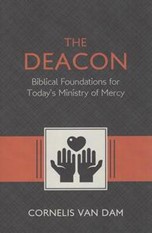Book Review: The Deacon: Biblical Foundations for Today’s Ministry of Mercy.
<- Back
The Deacon: Biblical Foundations for Today’s Ministry of Mercy.
Book Author: Cornelis Van Dam
Review Author: Richard Aasman
NONE Free Reformed Church
Pro Ecclesia Bookshop
This book review was first published in Clarion (Vol 66, no6 March 24 2017) and is here republished with kind permission of the author. Richard Aasman is Emeritus Pastor of the Providence Canadian Reformed Church, Edmonton, Alberta raasman@telusplanet.net
2016, 253 pages.
The Deacon, a much anticipated book by Dr. Cornelis Van Dam, acts as a perfect complement to his earlier book, The Elder: Today's Ministry Rooted in All of Scripture. The office of deacon is not always well understood in church circles, and can be undervalued. This book will help not only deacons and aspiring deacons, but all Christians to see the privilege, joy, and love in helping those in need.
The Deacon is divided into four main sections. Part One deals with Old Testament Background. Dr. Van Dam ably demonstrates that even without the official office of deacon in the Old Testament, all the principles of taking care of those in need are clearly laid out. God delivered his people from Egypt and wanted his people to live in joy and freedom. Therefore when anyone suffers, those around him or her must lovingly assist them. Need is not just a matter of lacking material necessities. It includes, for instance, those impaired physically or psychologically, those intimidated, exploited, and oppressed, as well as sojourners, strangers, and foreigners. The Old Testament makes clear that helping someone in need starts with the family. If more help is needed, then the wider community steps in. There are many laws that show how this is to be carried out. When Israel did not care for the poor, then God sent them into exile. This part of the book, like all the others, contains an abundance of Scripture references and explanations. Every section also sums up the contents of the section, reinforcing what the reader has learned.
Part Two takes the reader to the New Testament. Dr. Van Dam demonstrates how Jesus Christ in teaching and example helped the poor spiritually and materially. His greatest gift was going to the cross for sinners. He brought the joy of redemption to those oppressed by sin. That joy leads Christians to follow the example of Jesus Christ: love and generosity to others.
Dr. Van Dam carefully examines Acts 6 where seven men are ordained to serve at tables. He makes a good point that these seven are ordained to an office that would later be known as the office of deacon. These men did more than distribute material blessings. They came with the Word of God. This was a new office, closely connected to what the Old Testament and our Lord Jesus Christ taught about caring for those in need. It proved to be an enormous blessing that led to joy in the church. No one should live with any form of oppression that diminishes the joy of salvation in Jesus Christ.
Careful attention is paid to the requirements for those who are to be ordained as deacons. Their task is not only for the deacons themselves to focus on the needy, lonely, and sick, but to mobilize church members with gifts to help others both within and outside the congregation. Dr. Van Dam also tackles the question of whether having female deacons is biblical. He concludes that “the weight of evidence points to there not being ordained.” At the same time, godly women are enlisted to help in special cases of need.
Part Three examines the office of deacon in the history of the church. During the early and medieval times, the deacons lost their function. The Reformation brought the office back to its legitimate place and task. It is very interesting to read of Calvin’s understanding of the office of deacon. He saw two grades of deacon: those ordained to distribute alms, and those appointed but not ordained to visit the poor and sick. Calvin saw the latter as the widows Paul mentions in 1 Timothy 5:9-10. While Calvin’s teaching did not catch on in a big way, it demonstrates the valuable role that women have in serving the congregation.
Part Four examines the current functioning of deacons. The deacon is an office-bearer equal to elders. Deacons and elders work together, but also maintain distinct roles in the congregation. Dr. Van Dam makes a good point that deacons are not elders in training. Deacons have a valuable and challenging office. Attention is given to proper training for the office of deacon. Part of this is how families and the congregation prepare men for office.
Attention is given to how deacons go about meeting difficult situations. Here the Old Testament principle that families take care of their own is something deacons need to take into account. Deacons are men who need wisdom and discretion as they go about their task. When it comes to visitation, deacons should not just respond to requests for help. Dr. Van Dam makes a compelling argument that deacons should visit the entire congregation over a period of time. In these visits they can explain their office, discover gifts among the members, and mobilize everyone to use their gifts for the benefit of one another. Much valuable insight and practical advice is given that will help deacons to work with different kinds of needs, and the kind of challenges they might face. Deacons will find this section very helpful.
In keeping with Galatians 6:10 there is an obligation to extend help to those outside the church community, with an eye to the entire world. The church is to be a light to the world. There are some really valuable suggestions how a local congregation can reach out to the community with the gospel as they help those in need. Dr. Van Dam ends his book with showing the blessings of the work of the deacons. There are obvious blessings to the poor and to the congregation. But there is also a blessing to the faithful deacon who gains “a greater sense of confidence in God and assurance of salvation.”
This is followed by a question section that allows for further study and reflection. This is well done and helpful. Dr. Van Dam also provides two lists of resources. The latter is very helpful in assisting anyone who wants to dig deeper into certain aspects of the book. There is also a thorough Scripture and subject index.
The Deacon, while clearly showing good scholarly work, is written in a clear and practical way for all. It is a much welcomed book that speaks about an important aspect of church life that is not always well understood. It is a must read for any deacon or aspiring deacon. It is valuable to all Christians who long for a biblical perspective on living joyfully and thankfully together as a congregation. For me, this book has revived appreciation for the office of deacon.

